

Designation:VHT-2 Spartas Veritech Hover Tank (-2, -2A1, -2A2) |
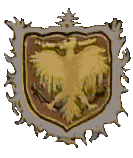
|
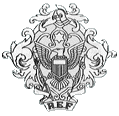
|
|||
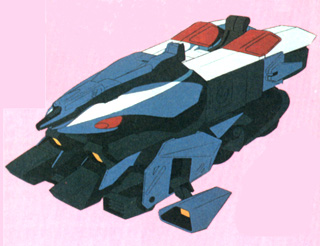
|
|||||
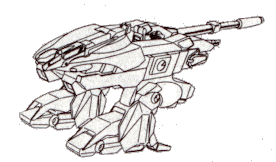
| Hovercraft | Tank | Battloid | |
|---|---|---|---|
| Length : | 6.0 meter | 7.75 meter | - |
| Depth : | - | - | 2.0 meter |
| Height : | 2.25 meter | 4.5 meter | 6.2 meter |
| Width : | 2.7 meter | 2.25 meter | - |
| Breadth : | - | - | 4.4 meter |
| Weight : | 26.4 metric tons. |
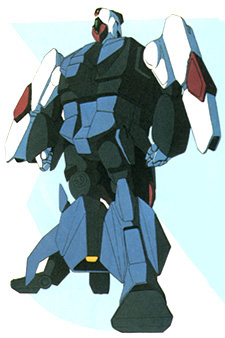
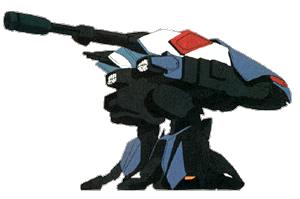
| 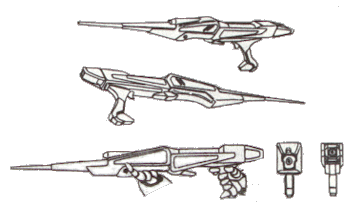 |
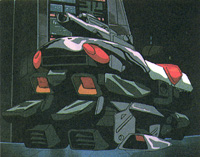
The armor on the Hover Tank is a new development in low-mass composite-materials Chobham plating that became the standard for all Terran mecha after its application to the VQ-6A Vandal. Aside from the respectable protection provided against projectiles, missiles, and other kinetic weapons, this armor is also resistant to plasma globes (annihilation discs), lasers, and to a lesser extent, particle guns. This is owing to the fact that the armor can flake off and evaporate in layers under fire from such high-energy weapons, taking much of the weapon's energy and converting it into the latent heat of sublimation in the armor.
The armor stops all small arms, heavy infantry weapons fire, and light mecha-mounted weaponry, and provides good resistance to medium mecha-mounted weaponry, such as the Valkyrie's 55mm APFSDS round, and poor resistance to heavy mecha-mounted weaponry, such as the VHT's 105mm smoothbore shells.
The main cannon and tri-cannon are mounted in armored housings on arms that have a thicker armor, and are often used to parry incoming fire. Here the armor resistance is better than that of almost any other mecha, except the HWR series Destroid.
The armored pilot compartment is proof against all shrapnel and environmental hazards, but can not withstand any strikes by shells (at non-perpendicular angles) larger than 30mm. Unfortunately, severe performance and reliability problems with the VR systems caused the pilot compartment to be removed from the tanks, even in combat.
When equipped with the armored pilot compartment, the VHT provides full protection from nuclear, biological, and chemical hazards, using an overpressure cockpit environment activated by radiation and hazardous chemical sensors, or manually when biological warfare conditions are anticipated. The internal consumables supplies can provide atmosphere for eight hours maximum.
The Hovertank was developed in reply to the specification in 2013 by the UEG High Command directive for a new ground scout vehicle to replace the Centaur Veritech light tank then in service. The commanders of the RDF Army drew up the specifications for a scout mecha with far superior mobility over the Centaur, but also with the firepower to engage any Zentraedi mecha, or even mecha more heavily armored than those of the Zentraedi. The latter was drawn with one eye to the internal politics of the Earth itself, and the VHT was from the outset intended to be capable of dispatching all Terran tanks and other fighting vehicles. In addition, the design was to have an alternate form to engage in close in combat.
From the contestants, two designs were chosen for prototype building and performance evaluation. These two were the VHT-2 Spartas and the VHT-1A2 Centaur II, an upgrade of the RDF Army Centaur.
The VHT-2 took the lead in this competition because of the superior mobility and reduced crew requirements. (the VHT-1 is a two-man mecha). In addition, the 105mm high velocity cannon of the VHT-2 proved to be a far superior weapon to the complex 152mm rocket/shell cannon on the VHT-1A2. Not unimportant, it was also both more reliable and easier to maintain. The main drawback was what were termed 'teething problems' with the armored compartment that protected the pilot. The electronics that created a virtual reality of the surroundings on the inside of the hood were decidedly sub-par, to the point that most of the test program was run with the compartment removed and the pilot exposed.
Consequently, in 2017, after a protracted testing period (during which the project repeatedly shifted up and down in priorities due to the demands on funds, personnel and material caused by the Zentraedi Malcontent Uprisings), the VHT-2 was announced as the winner, and a pre-production series was followed in 2019 by full series production.
The vast majority of procurements of this mecha were by the Southern Cross, for the Alpha Tactical Armored Corps. Several thousands of VHT-2 were produced before and during the Second Robotech War, but their drivers were somewhat apprehensive about their mecha, for it was a victim of mission creep during the late 2020's. In addition to their designed scout role, the VHT-2 was later designated to be part of the fast-reaction forces, and to be among the first mecha to attack alien landings. Far worse, however, were the 'teething problems' with the pilot compartments which remained unsolved due to limited funding, bureaucratic inertia and numerous audits and policy reviews. This forced even the front line units to go into combat with the pilot riding in the open atop the mecha in transport and tank modes. Despite this criminal state of affairs, skilled handling by the unit commanders (and timely conversions to battloid mode) made the VHT-2 Spartas a moderate success in this tasking in the Second Robotech War. One-on-one, the VHT-2 was superior to the earlier series of Bioroids employed by the Robotech Masters, and at least equal to the later Bioroid designs, including the vaunted 'Invid Fighter Triumvirates'. The Second Robotech War saw the Southern Cross' Spartas fighting everywhere on Earth, as well as in space.
The main armament of the VHT-2 was an extremely reliable 105mm smoothbore, which was capable of destroying any known enemy mecha with one round. The only drawback to the design was the limited payload. This was not considered a serious liability given its designed mission. The EU-11 laser rifle likewise proved itself to be a very rugged gun with a heavy punch. The plasma cannon was somewhat out of place on this mecha. As an energy weapon it was merely average in yield and effectiveness. To its credit, it did have an unlimited amount of ammunition available.
However, as the VHT-2's mission started expanding, new weapon fits were considered. Just before the Second Robotech War, the Southern Cross chose to refit some VHT-2's with new weapons and armor. Dubbed the VHT-2A1, the upgraded tanks had the smoothbore cannon removed and in its place was installed an ion cannon. This eliminated all ammunition constraints on the main gun. Although many Hovertanks never had the chance to be upgraded before the Invid's arrival, the -2A1 saw service in a limited capacity as early as the first year of the Second Robotech War and proved popular with its crews, although a complaint was often heard that the troops would have preferred to get their armored pilot compartments debugged instead. During the war itself, a successor for the VHT was called for, and the VHT-2A2 was designed in response. The result was a competition between the VHT-2A2 and the VHT-3 Conqueror, the latter a redesigned upsized follow-up of the VHT's old Centaur competitor. The VHT-2A2 was a derivative of the -2A1, with upgraded fire control, an uparmored crew compartment (though still with faulty electronics) and explosive-reactive armor in key locations. The VHT-3 had improved armament as well, in addition to drastic redesigns of its chassis.
All suitable factories were naturally tooled for the VHT-2, and would need only minimal retooling for the VHT-2A2. Given the war that was going on, this pushed the decision once again in the Spartas's favor. Several dozen VHT-2A2 Hovertanks were completed, tested, and issued to select ATAC squadrons just before the war's end, but this model was never mass-produced due to the serious devastation caused by the war, and series production was planned to start on what turned out to be three months after the Invid Invasion. Ironically, a debugged armored pilot compartment was finally cleared for production six days before the Invid invasion.
Go to the Hovertank Image Gallery.
A thin but long, high density (Tungsten) dart with a high muzzle velocity and little speed loss, giving a near instantaneous time-on-target. Due to the high flight speed, the round does not carry any guidance.
The MAPHE-SG is an anti-air artillery shell, with a warhead based on designs from the late 20th century. The shell incorporates a Lidar sensor and guides itself to the vicinity of the target, then fires four darts in an optimized firing pattern that virtually insures at least a 75% hit rate. These darts explode after penetrating the armor, destroying large parts of the internal structure of lightly armored targets, and large chunks of armor from heavier armored targets.
This shell has a proximity fuse to explode above troop concentrations and releases hundreds of hypervelocity darts. Especially effective against body armor and light APCs, the effectiveness of this round is diminished by cover such as buildings. The round has some secondary capability against helicopters and other low and slow flying targets.
This round will impact on a target, crush the thin plating of the round and smear the plastic explosive inside over the armor of the target. A base fuse will detonate the plastic, causing a scab of armor to shatter. The shell is variable fused, and can be used as a general-purpose High Explosive shell. With impact fuse this shell is especially effective against Zentraedi battlepods.
Delivers a seismic/passive EM sensor and radio link to an area. Can stay active for two months.
Smoke and illumination/white phosphorus rounds are also available.
Late in the Second Robotech War a plasma shell was developed as replacement for the HESH and MPAF shells, but only a few thousand of this version were produced before the SC fell to the Invid. It was a most impressive round, releasing 30 MJ of thermal energy on impact.
A boosted tactical nuclear device, available only through direct order of the SC High Command, with a yield of 1 kiloton.
This shell is a special weapons round, available only through direct orders of the Southern Cross Division General or his superiors.
Return to Southern Cross Veritech Index.
Go to Robotech Reference Guide Home Page.
Robotech (R) is the property of Harmony Gold. This document is in no way intended to infringe upon their rights.
Content by Pieter Thomassen and Peter Walker, with Tim Wing and Rob Morgenstern
HTML by Robert Morgenstern (rmorgens@ieee.org)